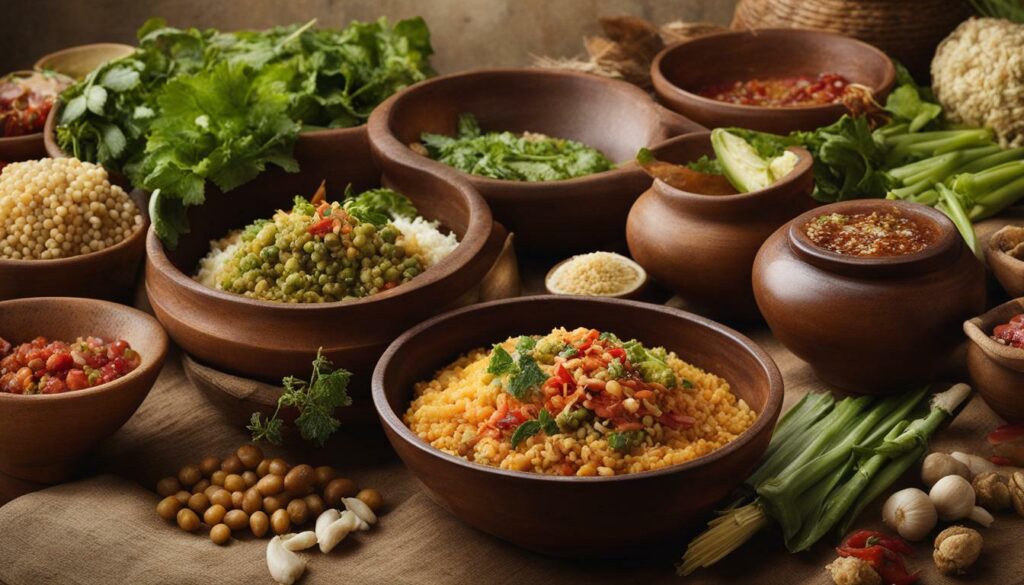Dive into our examination of past and present diets around the world, tracing how culinary norms have evolved across cultures and centuries. Understanding the historical diets and traditional food choices of different countries provides valuable insights into the changing patterns of consumption over the years.
Factual data reveals that past and present diets can be measured in terms of grams consumed per person or calories per person. National Geographic’s website, drawing from FAOSTAT data, provides a breakdown of food consumption in various countries, presenting a comprehensive view of global food habits.
Key Takeaways:
- Exploring past and present diets helps us understand how culinary norms have evolved.
- Data from National Geographic and FAOSTAT offer insights into global food habits.
- Traditional diets are characterized by high fibre and grain intake.
- Modern diets often feature high consumption of meat, sugar, oils, and fats.
- Sustainable food consumption aligns with some aspects of traditional eating, such as low meat consumption and local food sourcing.
Global Food Habits: A Historical Perspective
Explore the historical evolution of global food habits and cultural eating habits, diving into ancient dietary practices across different civilizations. Understanding the way people have nourished themselves throughout history provides valuable insights into the development of culinary traditions and the factors that have influenced food choices.
Ancient civilizations had diverse dietary practices that were shaped by their geographical location, available resources, and cultural beliefs. For example, the Egyptians relied heavily on grains such as barley and emmer wheat, while the Inca civilization in South America cultivated potatoes, quinoa, and maize. Meanwhile, the ancient Chinese emphasized the consumption of rice, noodles, and soybeans, while the Persians incorporated dates, figs, and yoghurt into their diets.
As societies progressed and interacted with one another, global food habits began to intertwine. The spice trade played a crucial role in connecting different parts of the world and influenced the flavours and ingredients used in various cuisines. The explorations of Christopher Columbus and other European explorers not only resulted in the discovery of new lands but also introduced new foods to different cultures.
To understand the historical context of global food habits, examining the dietary practices of ancient civilizations is essential. By studying the eating habits of our ancestors, we can gain insights into nutrition patterns, sustainability, and the cultural significance of food. These insights can guide us as we navigate the future of food, taking into account the importance of preserving culinary traditions, promoting sustainable practices, and ensuring food security for a growing global population.
Ancient Dietary Practices
To fully grasp the evolution of global food habits, it is crucial to delve into the specific dietary practices of ancient civilizations. The table below provides a snapshot of some key ancient dietary practices from different parts of the world.
| Civilization | Main Food Staples |
|---|---|
| Egyptians | Barley, Emmer Wheat, Fish, Figs |
| Inca | Potatoes, Quinoa, Maize |
| Ancient China | Rice, Noodles, Soybeans |
| Persians | Dates, Figs, Yogurt |
Exploring the dietary practices of ancient civilizations not only broadens our understanding of food history but also highlights the rich diversity that exists within global food habits. These ancient dietary practices have left lasting legacies, shaping the way we eat and the cultural significance of certain foods in different societies.

Traditional Diets: Ancestral Food Choices
Discover the significance of traditional diets and delve into the ancestral food choices that shaped historical nutrition patterns. The study of traditional eating patterns provides valuable insights into the culinary customs of our ancestors and how their food choices influenced their health and well-being.
Ancient societies relied on locally available resources to sustain their nutritional needs. Traditional diets were centred around whole foods, often including a variety of grains, legumes, vegetables, fruits, and lean protein sources, such as fish and poultry. These diets were rich in fibre and provided a balanced intake of essential nutrients.

Let’s now take a closer look at some specific examples of traditional diets that shaped historical nutrition patterns:
| Diet | Food Choices | Nutritional Highlights |
|---|---|---|
| Mediterranean Diet | Fruits, vegetables, whole grains, legumes, olive oil, moderate amounts of fish, and dairy products | Rich in omega-3 fatty acids, lean protein, fibre, and phytochemicals |
| Japanese Diet | Rice, fish, seaweed, soy products, vegetables, and pickled foods | Seafood, including fish, seals, walrus, whales, and marine mammals |
| Inuit Diet | Seafood, including fish, seals, walrus, whale, and marine mammals | High in omega-3 fatty acids, vitamin D, and protein, with minimal carbohydrate intake |
These traditional diets illustrate the diversity of food choices across different cultures and regions, highlighting the importance of considering ancestral diets when shaping our own nutritional choices.
Modern Diets: The Shift from Traditional Eating
Understand the shift from traditional to modern diets and explore the factors that have led to this change, including globalization, modernization, urbanization, and increased access to food. Over the last fifty years, consumption patterns have undergone significant transformations, affecting the diets of people worldwide. This shift can be measured in terms of grams consumed per person or calories per person and is crucial for understanding the current state of global food habits.
Modern diets are often characterized by high consumption of meat, sugar, oils, and fats. These dietary changes are closely linked to the influences of globalization, which have enabled the spread of Western eating habits and the availability of processed and convenience foods. The convenience and affordability of these foods, combined with the changing lifestyles and demands of an urbanized world, have led to a departure from traditional eating patterns in many societies. As individuals have gained increased access to food, their diets have shifted towards more processed and energy-dense options.
Contrastingly, traditional diets, shaped by centuries of culinary practices, tend to prioritize whole, unprocessed foods. They are often characterized by higher fibre and grain intake, with an emphasis on local and seasonal produce. Traditional diets have been linked to better health outcomes, as they provide a wider range of nutrients and lower intake of added sugars and unhealthy fats. With the growing interest in sustainable food consumption, there is a renewed focus on the wisdom of traditional eating and its alignment with environmental and personal well-being.
The Influence of Ancestral Diets on Culture
The food our ancestors ate has played a significant role in shaping our culture and culinary traditions. Exploring ancestral diets enables us to gain insights into the historical connections between food and communities. By studying traditional food choices, we uncover the diverse ways in which different populations obtain and consume food. These insights can inform our understanding of how to feed a growing global population while promoting sustainable practices and maintaining cultural diversity.

| Modern Diets | Traditional Diets |
|---|---|
| High meat consumption | Low meat consumption |
| High sugar, oils, and fats intake | Lower intake of added sugars and unhealthy fats |
| Processed and convenience foods | Whole, unprocessed foods |
| Globalized food choices | Locally sourced and seasonal produce |
Contrasting Nutritional Profiles: Traditional vs Modern Diets
Compare the nutritional profiles of traditional and modern diets, contrasting high meat, sugar, and fat consumption in modern diets with the high fibre intake characteristic of traditional diets. These consumption patterns have evolved over the past fifty years, influenced by factors such as globalization, modernization, urbanization, and increased access to food.
In modern diets, meat consumption has significantly increased. Animal products, especially red and processed meats, have become staple foods in many societies. This shift towards a higher meat intake can be attributed to various factors, including a rise in disposable income, changes in food production systems, and cultural influences. However, excessive meat consumption has been linked to various health issues, such as cardiovascular diseases and certain types of cancers.
Another notable aspect of modern diets is the increased consumption of sugar, oils, and fats. Processed foods, sugary beverages, and snacks have become widespread, leading to an overconsumption of added sugars and unhealthy fats. Excessive sugar consumption is associated with a higher risk of obesity, diabetes, and other metabolic disorders. Similarly, the consumption of unhealthy fats, such as trans fats and saturated fats, contributes to heart diseases and other health problems.
On the other hand, traditional diets prioritize whole, unprocessed foods, with a focus on high fiber intake. Traditional diets are often rich in fruits, vegetables, whole grains, legumes, and nuts. These foods provide essential nutrients, fibre, and antioxidants, which promote better digestion, lower cholesterol levels, and reduce the risk of chronic diseases. The high fibre intake of traditional diets not only aids in digestion but also contributes to a feeling of fullness, thereby reducing the likelihood of overeating and obesity.
| Nutrition Profile | Traditional Diets | Modern Diets |
|---|---|---|
| Meat Consumption | Low to moderate | High |
| Sugar Consumption | Low | High |
| Fat Consumption | Healthy fats | Unhealthy fats |
| Fiber Intake | High | Low |
As societies continue to grapple with the health consequences of modern diets, there is a growing interest in adopting sustainable food consumption practices. This involves a return to some elements of traditional eating, such as reducing meat consumption and prioritizing locally sourced foods. By embracing sustainable food choices, individuals can contribute to a healthier planet and potentially improve their well-being.
Understanding the contrasting nutritional profiles of traditional and modern diets provides valuable insights into the impact of dietary patterns on health. By incorporating more elements of traditional diets, such as high fibre intake and whole, unprocessed foods, individuals can promote better nutrition and overall well-being.
References:
- World Health Organization. (2015). Obesity and overweight. Retrieved from https://www.who.int/news-room/fact-sheets/detail/obesity-and-overweight.
- Harvard T.H. Chan School of Public Health. (n.d.). The Nutrition Source. Retrieved from https://www.hsph.harvard.edu/nutritionsource/.

Examine the concept of sustainable food consumption and its overlap with traditional eating habits, including low meat consumption and a focus on locally sourced foods. In recent years, there has been a growing interest in adopting sustainable food practices as a way to minimize the environmental impact of our diets and promote healthier lifestyles. This shift towards sustainability often involves a return to some of the principles that were once intrinsic to traditional eating habits.
Traditional diets, rooted in history and culture, often prioritize the use of locally sourced ingredients. By opting for locally produced foods, individuals can reduce their carbon footprint by minimizing the transportation distance of their meals. Additionally, supporting local farmers and food producers can help strengthen local economies and promote a sense of community.
Another characteristic of traditional diets is their low meat consumption. Unlike modern diets that heavily rely on animal products, traditional diets often incorporate a variety of plant-based proteins, such as legumes, grains, and vegetables. This reduces the overall demand for meat production, which has been linked to deforestation, greenhouse gas emissions, and water pollution.

The benefits of sustainable food consumption extend beyond environmental aspects. By adopting a more plant-based diet and reducing meat consumption, individuals can enjoy a range of health benefits. Plant-based diets are typically lower in saturated fat and cholesterol, which can contribute to the prevention of chronic diseases such as heart disease, obesity, and diabetes.
In conclusion, sustainable food consumption aligns with traditional eating habits that prioritize low meat consumption and a focus on locally sourced foods. By adopting these practices, individuals can contribute to a healthier planet, support local communities, and improve their well-being. Embracing the wisdom of our ancestors and incorporating sustainable food choices into our daily lives can pave the way towards a more sustainable and resilient future.
The Influence of Ancestral Diets on Culture
Uncover the profound impact of ancestral diets on culture, exploring how the food choices of our predecessors have shaped our culinary traditions and cultural practices. Our ancestors’ diets were not only a means of sustenance but also integral to their identity and way of life. From the staple ingredients they relied on to the cooking techniques they perfected, every aspect of their diet played a role in shaping their culture.
Traditional diets varied greatly across different regions and communities, reflecting the local environment, available resources, and cultural practices. These diets were often centred around locally sourced foods and seasonal produce, emphasizing a connection to the land and a sustainable approach to food consumption. For example, in coastal communities, fish and seafood were the mainstays of the diet, while inland regions relied heavily on grains, legumes, and vegetables.

The influence of ancestral diets on culture can still be observed today. Many culinary traditions and rituals have been passed down through generations, preserving the flavours and techniques that have stood the test of time. These traditional recipes not only provide nourishment but also serve as a link to our heritage, connecting us to our roots and fostering a sense of identity.
As we navigate an increasingly globalized world, understanding and appreciating ancestral diets can help us preserve our cultural heritage and make informed choices about our diets. By embracing traditional food practices, such as consuming locally sourced and seasonal ingredients, we can contribute to a more sustainable and harmonious relationship with the environment. Furthermore, exploring the dietary patterns of our ancestors can provide valuable insights into feeding a growing global population, ensuring food security without compromising the health of our planet.
Feeding a Growing Global Population: Insights from Ancestral Diets
Gain valuable insights into feeding a growing global population by studying ancestral diets, considering sustainable practices, and the significance of diverse food sources. Exploring past and present diets around the world involves understanding how consumption patterns have changed over the last fifty years. National Geographic’s website provides data from FAOSTAT, offering a breakdown of food consumption in various countries in terms of grams or calories consumed per person.
The shift from traditional to modern eating has been influenced by factors such as globalization, modernization, urbanization, and increased access to food. While modern diets often include high consumption of meat, sugar, oils, and fats, traditional diets are characterized by high fibre and grain intake. Understanding these dietary patterns helps us comprehend the complex relationship between culture, nutrition, and health.

There is a growing interest in sustainable food consumption, which aligns with some aspects of traditional eating. This includes low meat consumption and a preference for locally sourced foods. As we explore the food our ancestors ate, we gain valuable insights into sustainable practices and their significance for the future. It is fascinating to note how the food choices of our ancestors have shaped our cultural traditions and culinary practices.
For many communities, obtaining enough food from the landscape is still a matter of survival. Ancestral diets are a testament to the diverse ways in which different populations obtain and consume food. This knowledge can help us develop strategies to address the challenges of feeding a growing global population, and ensuring access to a nutritious and diverse range of foods.
| Traditional Diets | Modern Diets |
|---|---|
| High fiber and grain intake | High consumption of meat, sugar, oils, and fats |
| Emphasis on locally sourced foods | Increase in processed and fast foods |
| Lower environmental impact | Higher carbon footprint |
By embracing sustainable practices and drawing inspiration from ancestral diets, we can work towards a future where food security, cultural heritage, and environmental stewardship are harmoniously balanced. Understanding the lessons from the past can guide us in making informed choices in the present and ensure a thriving future for generations to come.
Conclusion
In conclusion, the examination of past and present diets around the world reveals the importance of understanding how culinary norms have evolved across cultures and centuries. Data from the National Geographic website, sourced from FAOSTAT, provides valuable insights into the grams consumed per person or calories per person in different countries, giving us a quantitative measure of food consumption patterns.
The shift from traditional to modern eating has been influenced by various factors, including globalization, modernization, urbanization, and increased access to food. Modern diets often exhibit high consumption of meat, sugar, oils, and fats, whereas traditional diets are characterized by a higher intake of fibre and grains. However, there is a growing interest in sustainable food consumption, which aligns with certain aspects of traditional eating such as low meat consumption and a focus on local foods.
Notably, ancestral diets have played a pivotal role in shaping our culture. The food our ancestors consumed has influenced our culinary traditions and cultural practices. Moreover, understanding ancestral diets can provide valuable insights into feeding a growing global population. As different communities still rely on obtaining enough food from their surrounding landscapes for survival, studying ancestral diets can shed light on sustainable practices and the importance of diverse food sources.
Through the exploration of ancestral diets, we gain a deeper understanding of the diverse ways in which different populations obtain and consume food. By considering the historical and cultural context of past and present diets, we can make informed choices about our dietary habits, while also working towards a more sustainable future.
FAQ
How can I access data on food consumption in different countries?
You can access data on food consumption in different countries on the National Geographic website, where data from FAOSTAT is used to provide a breakdown of food consumption in various countries.
What factors have influenced the shift from traditional to modern eating?
The shift from traditional to modern eating has been influenced by factors such as globalization, modernization, urbanization, and increased access to food.
How do traditional diets differ from modern diets in terms of nutritional profiles?
Traditional diets are characterized by high fibre and grain intake, while modern diets often include high consumption of meat, sugar, oils, and fats.
Is there a growing interest in sustainable food consumption?
Yes, there is a growing interest in sustainable food consumption, which aligns with some aspects of traditional eating, such as low meat consumption and high consumption of local foods.
How have ancestral diets influenced culture?
The food our ancestors ate has shaped our culture, influencing our culinary traditions and cultural practices.
Can understanding ancestral diets provide insights into feeding a growing global population?
Yes, understanding ancestral diets can provide insights into feeding a growing global population, considering sustainable practices and the importance of diverse food sources.
Source Links
- https://www.nationalgeographic.com/what-the-world-eats/
- https://bmcpublichealth.biomedcentral.com/articles/10.1186/s12889-019-7844-4
- https://www.nationalgeographic.com/photography/article/we-are-what-we-eat-documenting-dinners-around-the-world



